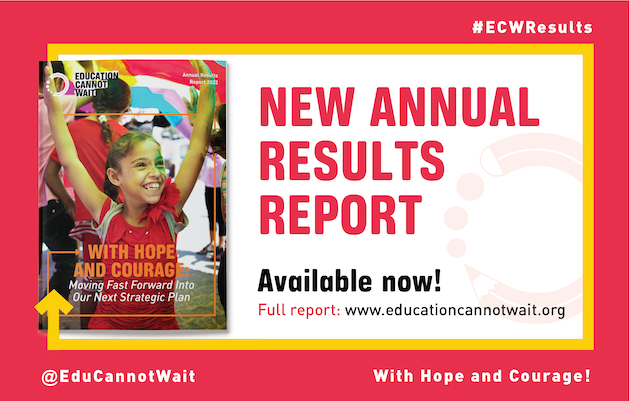ECWs New Report Shows Successful Education Funding Model for Crises-Impacted Children — Global Issues
UNITED NATIONS & NAIROBI, Sep 08 (IPS) – In a world set on fire by climate change and brutal conflict, millions of children in emergencies and protracted crises need educational support. Children in 48 out of 49 African countries are at high or extremely high risk of the impacts of climate change, particularly in the Central African Republic, Chad, Nigeria, Guinea, Somalia, and Guinea Bissau.
“We have reached catastrophic proportions of 224 million children today in conflict and other humanitarian crises in need of education support. Financial needs for education in emergencies within humanitarian appeals have nearly tripled over the last three years – from US$1.1 billion in 2019 to almost US$3 billion at the end of 2022. In 2022, only 30 percent of education requirements were funded, indicating a widening gap,” Education Cannot Wait (ECW) Executive Director Yasmine Sherif tells IPS.
Released today ahead of this month’s UN General Assembly and SDG Summit in New York, ECW’s ‘With Hope and Courage: 2022 Annual Results Report’ is a deep dive into the challenges, opportunities, key trends, and vast potential that “education for all” offers as nations across the globe race to deliver on the promises outlined in the SDG’s, Paris Agreement and other international accords.
Sherif stresses that as nations worldwide celebrate International Literacy Day – and the power of education to build sustainable and peaceful societies- ECW calls on world leaders to scale up financial support to reach vulnerable children in need, especially those furthest left behind. As more and more children are plunged into humanitarian crises, there is a widening funding gap as the needs have skyrocketed over recent years.
The report sends an urgent appeal for additional financing – featuring the latest trends in education in emergencies. It also shows the fund’s progress with UN and civil society partners in advancing quality education, particularly Sustainable Development Goal (SDG) 4 for vulnerable girls and boys in humanitarian crises worldwide to access inclusive, quality, safe education.
“While the number of out-of-school children in situations of conflict, climate-induced disasters, and as refugees is skyrocketing – funding is not keeping up with the snowballing crisis. But even in these unfortunate circumstances, the report has a positive message. ECW and its global strategic partners have reached 8.8 million children with quality, holistic education since its 2016 inception and more than 4.2 million in 2022 alone. The only reason we have not reached more children is insufficient funding. We have mobilized over $1.5 billion to date, and we need another $670 million to reach 20 million children by the end of our 2023-2026 strategic plan,” she observes.
Sherif emphasizes that the global community must ensure that girls and boys impacted by armed conflicts, climate-induced disasters, and forced displacement are not left behind but rather placed at the forefront for an inclusive and continued quality education. Education is the foundation for sustainable and peaceful societies.
“Our annual report demonstrates that it is possible to deliver safe, inclusive, quality education with proven positive learning outcomes in countries affected by conflict and to refugees. ECW has done it through strategic partnerships with host governments, government donors, the private sector, philanthropic foundations, UN agencies, civil society, local organizations, and other key stakeholders,” she explains.
“Together, we have delivered quality education to 9 million children and adolescents impacted by crises. The systems are in place, including a coordination structure; with more funding, we can reach more girls and boys in humanitarian crises around the world in places such as the Sahel, South Sudan, Yemen, Syria, and Latin America and enable girls to access community-based secondary education in Afghanistan. We have a proven efficient and effective funding model of delivering the promise of education.”
ECW has thus far financed education programmes across 44 countries and crisis settings. Of the 4.2 million children reached in 2022, 21 percent were refugees, and 14 percent were internally displaced. When the COVID-19 pandemic shut down schools across the globe, ECW repositioned its programming and supported distance learning, life-saving access to water and sanitation facilities, and other integrated supports – reaching an additional 32.2 million children.
ECW’s commitment to gender equality and tackling the gender gap in education is bearing fruit. Towards the fund’s goal of 60 percent girls reached in all its investments, girls represent over 50 percent of all children reached in 2022.
In 2022, ECW’s rapid First Emergency Responses to new or escalating crises included a strong focus on the climate crisis through grants for the drought in Eastern Africa and floods in Pakistan and Sudan. ECW also approved new funding in response to the war in Ukraine and renewed violence in the Lake Chad Region and Ethiopia.
“On scaling up funding for education, the report shows funding for education in emergencies was higher than ever before in 2022, and that total available funding has grown by more than 57 percent over just three years – from US$699 million in 2019 to more than US$1.1 billion in 2022,” Sherif explains.
With support from ECW’s key strategic donor partners – including Germany, the United Kingdom, and the United States, as the top-three contributors among 25 in total, and visionary private sector partners like The LEGO Foundation – US$826 million was announced at the ECW High-Level Financing Conference in early 2023.
In addition, collective resource mobilization efforts from all partners and stakeholders at global, regional, and country levels helped unlock an additional US$842 million of funding for education in emergencies and protracted crises, which contributed to alignment with ECW’s Multi-Year Resilience Programmes in 22 countries.
To date, some of ECW’s largest and prospective bilateral and multilateral donors have not yet committed funding for the full 2023–2026 period, and there remains a gap in funding from the private sector, foundations, and philanthropic donors. In the first half of 2023, ECW faces a funding gap of approximately US$670 million to fully finance results under the Strategic Plan 2023–2026, which will reach 20 million children over the next three years.
IPS UN Bureau Report
Follow @IPSNewsUNBureau
Follow IPS News UN Bureau on Instagram
© Inter Press Service (2023) — All Rights ReservedOriginal source: Inter Press Service
Check out our Latest News and Follow us at Facebook
Original Source







